Search Results for 'Brendan McGowan'
29 results found.
Claregalway heroes
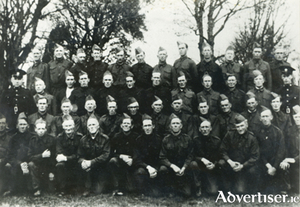
In the years following the establishment of the Defence Forces, various classes of Army Reserves were experimented with between 1927 and 1939. In May 1927, a Class A Reserve was formed consisting of NCOs and men transferred to the Reserve. In January 1928, a Class B Reserve was set up with the object of building up the infantry arm of the Defence Forces. One joined voluntarily, but in doing so, committed to three months initial training and one month’s annual training thereafter. This group had practically ceased to exist by 1934.
Historic bilingual publication of Pádraic Ó Conaire’s classic stories
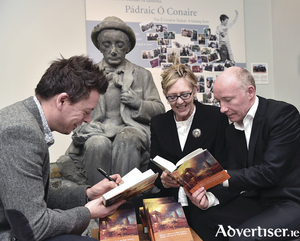
First published in Irish in 1918, Seacht mBua an Éirí Amach/Seven Virtues of the Rising is a collection of seven stories by Pádraic Ó Conaire (1882–1928), published in English for the first time. Despite the title of the collection, the stories themselves are not directly concerned with the actual events of the 1916 Rising, although there are several allusions to key figures and locations.
Pádraic Ó Conaire and the Rising
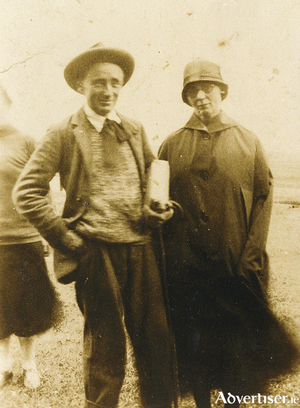
Pádraic Ó Conaire was born on February 28 1882 in a pub by the docks, to middle-class Catholic publicans. He briefly attended the Presentation National School, but when his parents both died young he went to live with some of his extended family in Rosmuc. He later went to school in Rockwell and from there to Blackrock College in Dublin. He emigrated to London and took a lowly job in the civil service. He joined the local branch of Conradh na Gaeilge and flourished as an Irish language teacher and writer. In 1901 he published his first short story, An t-Iascaire agus an File.
Pádraic Ó Conaire's 1916 stories re-launched
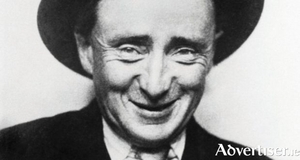
PÁDRAIC Ó Conaire's short stories about the 1916 Rising, Seacht mBua an Éirí Amach/Seven Virtues of the Rising, is to be re-launched in a new edition and translation by acclaimed Galway actor Diarmuid de Faoite.
St Michael’s GAA Club, sixty years
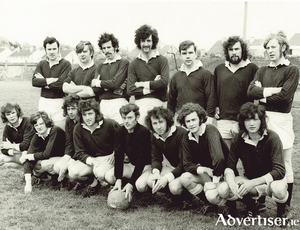
St Michael’s Club was formed in 1956 after Galway won the All-Ireland football final. The first AGM was held in Tom Connolly’s house in Lower Shantalla Road, and they played their first game in 1957. Among those who founded the club were Pa Boyle (whose brainchild it was), Mick O’Toole, John Duignan, Mick Higgins, Liam Cunningham, and Sergeant O’Toole. They started as a dual club, but after a few years they concentrated solely on football.
Exhibition to explore Galway's revolution
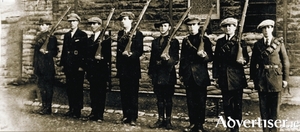
OUTSIDE OF Dublin, County Galway saw the most significant action of the 1916 Rising, and Galway's role in 1916, as well as the War of Independence and the Civil War, will be examined in a major new exhibition.
Republican prisoners in the Town Hall
This remarkable photograph was taken in 1920/21. It shows a group of republican prisoners who are being held in the Town Hall. They are surrounded by barbed wire and are being carefully watched by a soldier you can see standing beside the tin hut. He is wearing a ‘Brodie’ helmet which was a steel combat helmet invented by Englishman John Brodie during World War I. There were probably more soldiers on duty inside the hut watching the detainees, the photographer, and anyone else who might have been was passing. A notice on one of the windows reads “No one is allowed within ten yards of this building.”
The Proclamation Of King George V
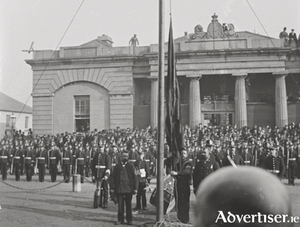
“The accession of His Majesty King George V was proclaimed in Galway at 2 o’clock on Saturday (21st of May, 1910). The ceremony was performed by the High Sherriff, Mr. Cecil R. Henry, and took place opposite the Courthouse. On the steps of the building there was a fashionable gathering. Outside the hollow square formed by soldiers and police, the crowd was one of immense proportions. About one hundred men of the Connaught Rangers, with their band and the King’s colour, under Major Sarsfield, were formed up in line opposite the Courthouse, and an equal number of the Royal Irish Constabulary, drawn from Galway and outside stations, filled up the remaining sides of the square. They were in charge of Co. Inspector Flower, Districts-Inspectors Mercer and O’Rorke.
The First Galway Brigade, 2nd Battalion
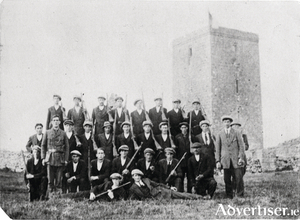
During the War of Independence, the Volunteers, for organisational purposes, divided the country into divisions. Connacht and County Clare were split into four such sections. In each of these, the members were divided into brigades, battalions, companies, and flying columns. The First Galway Brigade was divided into three battalions, Castlegar, Claregalway, and Headford.

